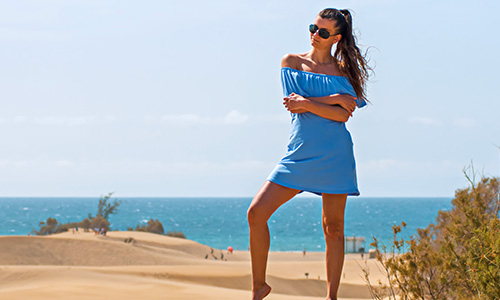Breathable Fabrics to Keep You Cool in the Scorching Heat
Author

Chris shares his passion for cycling, hiking, skiing, and climbing from Buxton, in the Peak District. As a blogger for Outdoor Look, Chris shares outdoor tips and indoor tricks to help you get the most out of your time spent outside. When he's not out adventuring he's making videos or trying to keep up with his 4-year-old son.
 Breathable fabrics not only help keep you cool but provide comfort, especially when you are moving or doing some kind of activity. For protection from the sun you have to choose the right kind of clothing that fits you perfectly.
Breathable fabrics not only help keep you cool but provide comfort, especially when you are moving or doing some kind of activity. For protection from the sun you have to choose the right kind of clothing that fits you perfectly.
Here are some factors that you must consider before buying clothing for warm-weather activities:
Check the Fabric Weight and Construction
Wearing tighter knit fabrics or thicker fabrics will only add to your discomfort and may probably cause rashes or allergies if you wear them too long. To gauge whether the fabric is breathable or not you can lift a piece of clothing in light and see if it passes through it. The thinner the fabric the more breathability you will get.
Find Moisture Controlling Fabrics
Breathable, lightweight-fabrics help reduce sweating, but the moisture-wicking fabrics go even further and take advantage of the body’s cooling mechanism to evaporate moisture.
Look for Correct Fitting
If all you are going to do is relax, then opt for much more loose fitting clothes; those opting for moisture wicking clothing must find a fit that stays in contact with your skin so that it can do its job. However, it is not necessary that the garment should be skin-tight.
Buy Clothing with Air Vents and Mesh Panels
Clothing specially designed for sun protection contains strategically placed zippered air vents and mesh panels. If you plan to do physical activities, it is advised that you buy such clothing that will give you comfort.
Pros and Cons of Breathable Fabrics
Reading about some of the characteristics of a variety of breathable fabrics will help you make the call on which one to buy. Below are the most commonly available fabrics with their pros and cons:
Cotton
Pros – durable and soft fabric that is easy to care for. Versatile in nature and is breathable.
Cons – not good for those who want to do some physical activity that will result in excessive sweating. The fabric absorbs moisture, causing it to become irritable after wearing for a while.
Polyester and Nylon
Present in almost every active-wear clothing.
Pros – helps resist abrasions and pilling. Easily wicks moisture and dries quickly.
Cons – retains oduor and less soft than cotton. Breathability varies depending upon the size, weave or knit.
Rayon
 Used in blended form to achieve different characteristics; Made of highly processed plant-based fabrics.
Used in blended form to achieve different characteristics; Made of highly processed plant-based fabrics.
Pros – dries quickly, easy to drape, moderately breathable, silky texture.
Cons – requires dry cleaning, less efficient at wicking away moisture than polyester and nylon fabrics, gets easily wrinkled
Linen
Popular fabric used for making casual summer wear. The fabric is derived from the stalks of flax plants.
Pros – durable and has greater breathability because of its large fibers. It is incorporated in clothing styles for more breathability through open weaving style.
Cons – absorbs moisture like cotton, wrinkles very easily. Poor choice in case you are wearing it during a physical activity that results in heavy precipitation.
Silk
Used in underwear and upscale casual wear.
Pros – lightweight, soft and breathable characteristics.
Cons – retains odours, requires hand washing, fragile material and does not wick away moisture.
Merino Wool
Mostly used in long underwear and winter wear and has a soft texture.
Pros – summer worthy, lightweight, breathable
Author

Chris shares his passion for cycling, hiking, skiing, and climbing from Buxton, in the Peak District. As a blogger for Outdoor Look, Chris shares outdoor tips and indoor tricks to help you get the most out of your time spent outside. When he's not out adventuring he's making videos or trying to keep up with his 4-year-old son.
- Speed Up Your Post-Hike Recovery with These 6 Essential Tips
- Cycling through Tranquil Roads and Coastal Views on the Isle of Wight
- The Essential Guide to Hiking Safety: 5 Tips Every Hiker Should Know
- Run Smart, Run Strong: Your Guide to Injury-Free Running
- Embrace Biking: Essential Tips for Beginners
Categories
- Sport (28)
- Product Reviews (3)
- Team Outdoor Look (7)
- Mike Wild (2)
- Mike Payton (2)
- Suse Hammond-Pears (3)
- Snowboarding (12)
- Latest Offers (105)
- Shop Talk (1)
- Competitions (7)
- Walking (413)
- Lifestyle Fashion (8)
- Travel (86)
- Kit Guides (176)
- Workwear Clothing (6)
- Safety Workwear (4)
- Health/Fitness (289)
- Skiing (91)
- Great Outdoors (1316)
- Cycling (92)
- January 2025
- December 2024
- November 2024
- October 2024
- September 2024
- August 2024
- July 2024
- June 2024
- May 2024
- April 2024
- March 2024
- February 2024
- January 2024
- December 2023
- November 2023
- October 2023
- September 2023
- August 2023
- July 2023
- June 2023
- May 2023
- April 2023
- March 2023
- February 2023
- January 2023
- December 2022
- November 2022
- October 2022
- September 2022
- August 2022
- July 2022
- June 2022
- May 2022
- April 2022
- March 2022
- February 2022
- January 2022
- December 2021
- November 2021
- October 2021
- September 2021
- August 2021
- July 2021
- June 2021
- May 2021
- April 2021
- March 2021
- February 2021
- January 2021
- December 2020
- November 2020
- October 2020
- September 2020
- August 2020
- July 2020
- June 2020
- May 2020
- April 2020
- March 2020
- February 2020
- January 2020
- December 2019
- November 2019
- October 2019
- September 2019
- August 2019
- July 2019
- June 2019
- May 2019
- April 2019
- March 2019
- February 2019
- January 2019
- December 2018
- November 2018
- October 2018
- September 2018
- August 2018
- July 2018
- June 2018
- May 2018
- April 2018
- March 2018
- February 2018
- January 2018
- December 2017
- November 2017
- October 2017
- September 2017
- August 2017
- July 2017
- June 2017
- May 2017
- April 2017
- March 2017
- February 2017
- January 2017
- December 2016
- November 2016
- October 2016
- September 2016
- August 2016
- July 2016
- June 2016
- May 2016
- April 2016
- March 2016
- February 2016
- January 2016
- December 2015
- November 2015
- October 2015
- September 2015
- August 2015
- July 2015
- June 2015
- May 2015
- April 2015
- March 2015
- February 2015
- January 2015
- December 2014
- November 2014
- October 2014
- September 2014
- August 2014
- July 2014
- June 2014
- May 2014
- April 2014
- March 2014
- February 2014
- January 2014
- December 2013
- November 2013
- October 2013
- September 2013
- August 2013
- July 2013
- June 2013
- May 2013
- April 2013
- March 2013
- February 2013
- January 2013
- December 2012
- November 2012
- October 2012
- September 2012
- August 2012
- July 2012
- June 2012
- May 2012
- April 2012
- March 2012
- February 2012
- January 2012
- December 2011
- November 2011
- October 2011
- September 2011
- August 2011
- May 2010
- April 2010
- March 2010
- February 2010
- January 2010
- November 2009
- October 2009
- September 2009
Submit a Comment